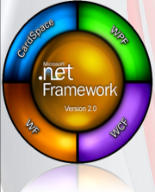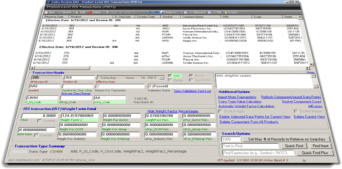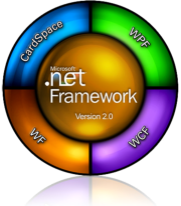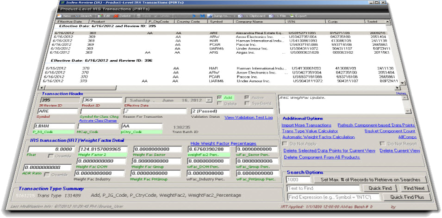



Microsoft Visual Studio and .NET Links
http://www.UniversalThread.com
- The UniversalThread
http://en.wikipedia.org/wiki/Microsoft_Visual_Studio
- The Microsoft Visual Studio Wikipedia
http://en.wikipedia.org/wiki/.NET_Framework
- The Microsoft .NET Wikipedia



Technology Services
J.C.N. Associates, L.L.C.
More

Microsoft Visual Studio .NET


Source of content includes Wikipedia
J.C.N. Associates, L.L.C.
IT Project Management
Microsoft Visual FoxPro
Microsoft Visual
Studio .NET

Microsoft .NET Application Development
The .NET Framework (pronounced dot net) is a software framework developed by Microsoft that runs primarily on Microsoft Windows. It includes a large library and provides language interoperability (each language can use code written in other languages) across several programming languages. Programs written for the .NET Framework execute in a software environment (as contrasted to hardware environment), known as the Common Language Runtime (CLR), an application virtual machine that provides services such as security, memory management, and exception handling. The class library and the CLR together constitute the .NET Framework. The .NET Framework's Base Class Library provides user interface, data access, database connectivity, cryptography, web application development, numeric algorithms, and network communications. Programmers produce software by combining their own source code with the .NET Framework and other libraries. The .NET Framework is intended to be used by most new applications created for the Windows platform. Microsoft also produces an integrated development environment largely for .NET software called Visual Studio.Microsoft Visual Studio
Microsoft Visual Studio is an integrated development environment (IDE) from Microsoft. It is used to develop console and graphical user interface applications along with Windows Forms applications, web sites, web applications, and web services in both native code together with managed code for all platforms supported by Microsoft Windows, Windows Mobile, Windows CE, .NET Framework, .NET Compact Framework and Microsoft Silverlight. Visual Studio includes a code editor supporting IntelliSense as w e l l as code refactoring. The i n t e g r a t e d d e b u g g e r works both as a source- l e v e l debugger and a machine-level debugger. Other built-in tools include a forms designer for building GUI applications, web designer, class designer, and database schema designer. It accepts plug-ins that enhance the functionality at almost every level—including adding support for source-control systems (like Subversion and Visual SourceSafe) and adding new toolsets like editors and visual designers for domain-specific languages or toolsets for other aspects of the software development lifecycle (like the Team Foundation Server client: Team Explorer). Visual Studio supports different programming languages by means of language services, which allow the code editor and debugger to support (to varying degrees) nearly any programming language, provided a language-specific service exists. Built-in languages include C/C++ (via Visual C++), VB.NET (via Visual Basic .NET), C# (via Visual C#), and F# (as of Visual Studio 2010). Support for other languages such as M, Python, and Ruby )among others) is available via language services installed separately. It also supports XML/XSLT, HTML/XHTML, JavaScript and CSS. Individual language- specific versions of Visual Studio also exist which provide more limited language services to the user: Microsoft Visual Basic, Visual J#, Visual C#, and Visual C++. Microsoft provides "Express" editions of its Visual Studio 2010 components Visual Basic, Visual C#, Visual C++, and Visual Web Developer at no cost. Visual Studio 2012, 2010, 2008 and 2005 Professional Editions, along with language-specific versions (Visual Basic, C++, C#, J#) of Visual Studio Express 2010 are available for free to students as downloads via Microsoft's DreamSpark program.

Microsoft Visual Studio and .NET Links
http://www.UniversalThread.com
http://en.wikipedia.org/wiki/Microsoft_Visual_Studio
http://en.wikipedia.org/wiki/.NET_Framework



Microsoft Visual Studio .NET
© J.C.N. Associates, L.L.C. 1991 - 2021
Voice: 646/583.2989 | Fax: 732/595.9125

Microsoft Visual FoxPro
IT Software Project Management

Source of content includes Wikipedia

J.C.N. Associates, L.L.C.
Microsoft Visual FoxPro
IT Software Project Management
© J.C.N. Associates, L.L.C. 1991 - 2025
Voice: 973/937.7809 | Fax: 732/595.9125 | Email: info@jcn-associates.com
Delivering IT Software Project Management and Visual FoxPro Proficiency Since 1991



- Home
- About JCN
- Why use JCN?
- Portfolio of Successful Projects
- Database Application Development
- IT Project Management
- Microsoft Visual FoxPro
- Professional Services
- Visual Studio .Net
- Hardware and Utilities
- Alex E. Luyando - Bio
- Alex E. Luyando - Resume
- Alex E. Luyando - LinkedIn
- For the Mind
- Contact Us























